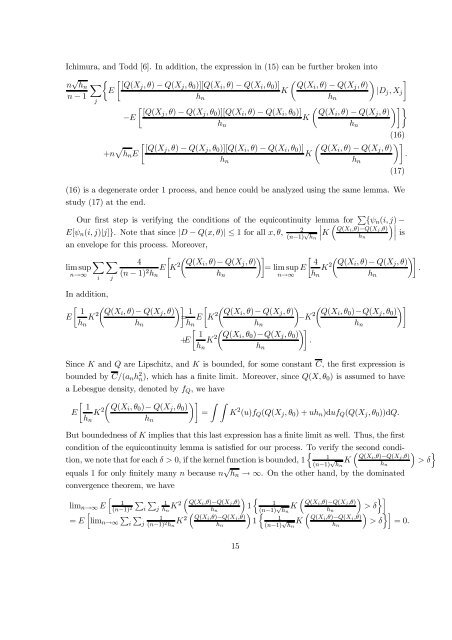On the Identification of Misspecified Propensity Scores - School of ...
On the Identification of Misspecified Propensity Scores - School of ...
On the Identification of Misspecified Propensity Scores - School of ...
You also want an ePaper? Increase the reach of your titles
YUMPU automatically turns print PDFs into web optimized ePapers that Google loves.
Ichimura, and Todd [6]. In addition, <strong>the</strong> expression in (15) can be fur<strong>the</strong>r broken into<br />
n √ hn<br />
n − 1<br />
<br />
<br />
[Q(Xj, θ) − Q(Xj, θ0)][Q(Xi, θ) − Q(Xi, θ0)] Q(Xi, θ) − Q(Xj, θ)<br />
E<br />
K<br />
|Dj, Xj<br />
j<br />
hn<br />
<br />
[Q(Xj, θ) − Q(Xj, θ0)][Q(Xi, θ) − Q(Xi, θ0)] Q(Xi, θ) − Q(Xj, θ)<br />
−E<br />
K<br />
hn<br />
(16)<br />
+n <br />
[Q(Xj, θ) − Q(Xj, θ0)][Q(Xi, θ) − Q(Xi, θ0)] Q(Xi, θ) − Q(Xj, θ)<br />
hnE<br />
K<br />
.<br />
hn<br />
hn<br />
(17)<br />
(16) is a degenerate order 1 process, and hence could be analyzed using <strong>the</strong> same lemma. We<br />
study (17) at <strong>the</strong> end.<br />
Our first step is verifying <strong>the</strong> conditions <strong>of</strong> <strong>the</strong> equicontinuity lemma for {ψn(i, j) −<br />
2<br />
E[ψn(i, j)|j]}. Note that since |D − Q(x, θ)| ≤ 1 for all x, θ,<br />
(n−1) √ <br />
Q(Xi,θ)−Q(Xj,θ) <br />
K<br />
is<br />
hn<br />
hn<br />
an envelope for this process. Moreover,<br />
<br />
lim sup<br />
4<br />
<br />
E K<br />
n→∞<br />
2<br />
<br />
Q(Xi, θ)− Q(Xj, θ)<br />
= lim sup<br />
<br />
Q(Xi, θ)− Q(Xj, θ)<br />
.<br />
n→∞<br />
i<br />
j<br />
(n − 1) 2 hn<br />
In addition,<br />
<br />
1<br />
E K<br />
hn<br />
2<br />
<br />
Q(Xi, θ)− Q(Xj, θ)<br />
=<br />
hn<br />
1<br />
<br />
E K<br />
hn<br />
2<br />
<br />
Q(Xi, θ)− Q(Xj, θ)<br />
hn<br />
<br />
1 Q(Xi, θ0)−Q(Xj, θ0)<br />
+E<br />
.<br />
K<br />
hn<br />
2<br />
hn<br />
hn<br />
hn<br />
<br />
4<br />
E K<br />
hn<br />
2<br />
−K 2<br />
hn<br />
hn<br />
<br />
Q(Xi, θ0)−Q(Xj, θ0)<br />
Since K and Q are Lipschitz, and K is bounded, for some constant C, <strong>the</strong> first expression is<br />
bounded by C/(anh 2 n ), which has a finite limit. Moreover, since Q(X, θ0) is assumed to have<br />
a Lebesgue density, denoted by fQ, we have<br />
<br />
Q(Xi, θ0)− Q(Xj, θ0)<br />
=<br />
<br />
1<br />
E K<br />
hn<br />
2<br />
hn<br />
hn<br />
K 2 (u)fQ(Q(Xj, θ0) + uhn)dufQ(Q(Xj, θ0))dQ.<br />
But boundedness <strong>of</strong> K implies that this last expression has a finite limit as well. Thus, <strong>the</strong> first<br />
condition <strong>of</strong> <strong>the</strong> equicontinuity lemma is satisfied for our process. To<br />
verify <strong>the</strong> second condi-<br />
1<br />
tion, we note that for each δ > 0, if <strong>the</strong> kernel function is bounded, 1<br />
(n−1) √ hn K hn<br />
equals 1 for only finitely many n because n √ hn → ∞. <strong>On</strong> <strong>the</strong> o<strong>the</strong>r hand, by <strong>the</strong> dominated<br />
convergence <strong>the</strong>orem, we have<br />
<br />
limn→∞ E 1 <br />
= E<br />
<br />
limn→∞<br />
(n−1) 2<br />
<br />
i<br />
i<br />
<br />
j<br />
<br />
j 1<br />
hn K2<br />
1<br />
(n−1) 2 hn K2<br />
Q(Xi,θ)−Q(Xj,θ)<br />
hn <br />
Q(Xi,θ)−Q(Xj,θ)<br />
hn<br />
15<br />
<br />
1 1<br />
(n−1) √ hn K<br />
<br />
1 1<br />
(n−1) √ hn K<br />
Q(Xi,θ)−Q(Xj,θ)<br />
hn <br />
Q(Xi,θ)−Q(Xj,θ)<br />
hn<br />
Q(Xi,θ)−Q(Xj,θ)<br />
<br />
<br />
> δ<br />
<br />
> δ<br />
= 0.<br />
<br />
<br />
> δ
















